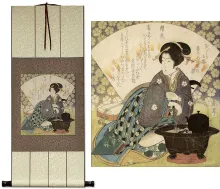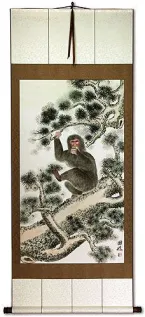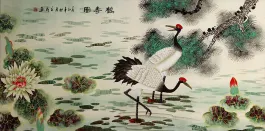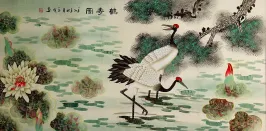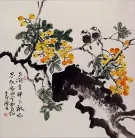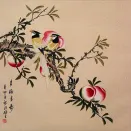Young Women Beneath A Cherry Tree
Japanese
Wall Scroll

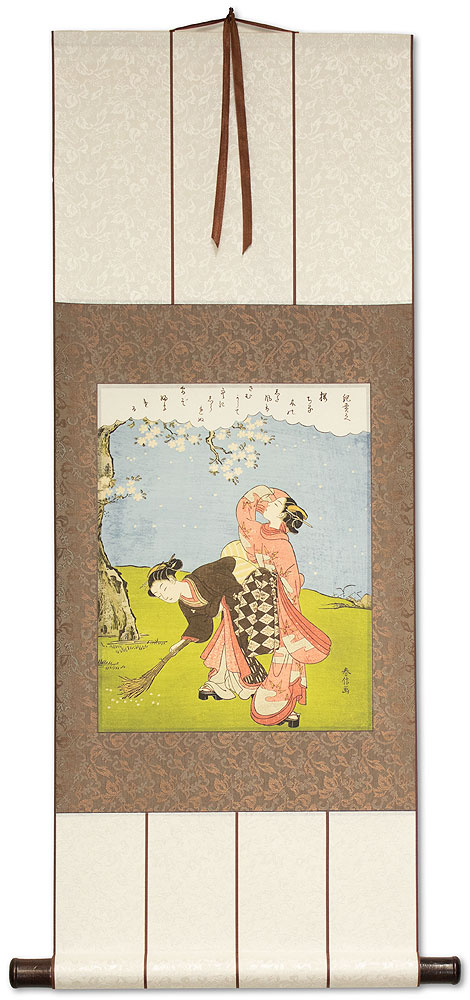
38¾"
18"
• Delivered to you in Columbus by Dec 16th.
• Standard shipping is just $3.80 for any order.
• Just 1 in stock now.
• Handmade Wall Scroll.
• Money-Back Guarantee.

This artwork will look great in your home or office.
Approximate Measurements
Artwork Panel: 28.2cm x 35.8cm ≈ 11" x 14"
Silk/Brocade: 37cm x 98.2cm ≈ 14½" x 38¾"
Width at Wooden Knobs: 46cm ≈ 18"
Information about caring for your wall scrollSee Larger Image
Young Women Beneath a Cherry Tree
Featuring a poem by Ki no c
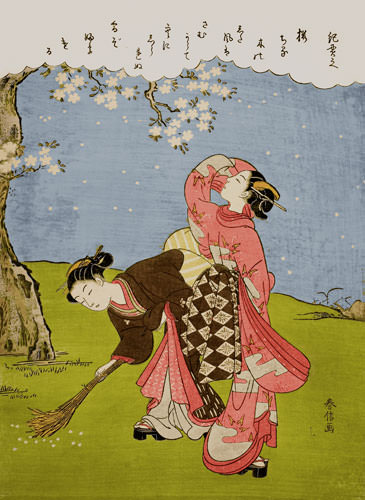
Close up view of the artwork mounted to this silk brocade wall scroll
This Japanese woodblock print reproduction features two young women beneath a cherry-tree in full bloom. One girl is shielding her head with her sleeve as she looks up toward the scattering flowers. The other, with a twig broom, sweeps up the cherry blossoms.
The artist has written the text of a poem above and seems to be comparing the white cherry blossoms to snow in this poem by 紀貫之 (Ki no Tsurayuki) written around the year 913 AD.
The 短歌 (short poem) is in the ancient Japanese 5-line 5-7-5-7-7 syllable arrangement. It reads:
Sakura chiru,
ko no shita kaze wa
samukarade
sora ni shirarenu
yuki zo furikeru.
Many have tried to artfully-translate this poem. Here are a few of the attempts:
Under cherry trees,
the breeze was gentle and warm
as blossoms slowly fell.
But in the high unknown sky,
countless snowflakes swirled.
The wind that scatters
cherry blossoms from their boughs
is not a cold wind--
and the sky has never known
snow flurries like these.
Under the cherry tree
which sheds its blossoms
the wind is not cold;
but unknown to the sky,
snow falls.
Original artist: Suzuki Harunobu 鈴木春信 (1725–1770).
The original woodblock was carved/created in Japan around 1767 or 1768.
It is signed 春信画 (Harunobu's picture) at the lower right.
An original print with the same image as this reproduction sold at Sotheby's for 9,000 British Pounds (about $13,300). So this one is the affordable option for most of us who don't have a $13,300 art budget but do have a monthly car payment.
sothebys.com/en/auctions/ecatalogue/2004/japanese-print-collection-l04753/lot.76.html
Suzuki Harunobu was raised in Kyoto. He came from a Samurai family of some standing (though not without some troubles in the family history). Suzuki Harunobu was the first to create full-color prints known as "nishiki-e" around 1765. Up to that time, prints were usually made with no more than three colors from three wooden printing blocks. Suzuki Harunobu's specialties included classical poems and Bijin or beautiful women (often drawn thinner and younger than other artists' work - capturing a more youthful image).
About Real Japanese Woodblock Prints
Woodblock printing, often considered the precursor to the modern printing press, was first developed in China and later brought to Japan, where artists refined the technique into a unique art form. In Japan, these prints are called 木版畫 ("Moku Hanga"). Most were created during the Edo period (1603–1867), though production continued into the early 20th century.
Japanese artists would first create a "template painting" depicting scenes of daily life, including women washing clothes, men writing poetry, samurai battles, and occasionally more dramatic subjects. These template images, known as 浮世絵 (Ukiyo-e, or "Floating World"), were then carved into wood by skilled artisans. Another specialist applied wet ink or pigments to the carved blocks, and a sheet of handmade paper was pressed on to create the final print. This collaborative process produced vibrant, detailed artworks much faster than hand-painting hundreds of copies.
About This Reproduction
Original Japanese woodblock prints from the Edo period can sell for $800 to $20,000. Our prints are high-quality reproductions, crafted to capture the look and feel of the originals, though experts will recognize them as reproductions.
We use authentic handmade kozo (mulberry) paper—the same paper Japanese printmakers used centuries ago. Archival, UV-resistant pigment inks ensure long-lasting color, with laboratory testing showing up to 95 years of fade-free enjoyment if kept out of direct sunlight. Each reproduction is carefully color-corrected and restored, bringing the Edo period artwork to life for your wall.

Photographer Jeremy Cowart and the Canon imagePROGRAF PRO-2000 giclée printer used to create these reproductions.
Printing on delicate handmade paper is challenging. After testing multiple high-end printers, we found the Canon imagePROGRAF PRO-2000 delivers the precision and quality needed, using 12 archival inks and 18,432 nozzles. Each print is then sent to our Beijing workshop, where it is mounted into a handmade wall scroll, ready-to-hang without the need for expensive framing, giving your piece an authentic Japanese look.
Because the original artist has long passed, these works are public domain. In some cases, we license high-resolution scans of original prints, or even scan 200-year-old originals ourselves. This dedication ensures you receive a stunning Japanese woodblock print reproduction at an affordable price, making traditional Asian art accessible to everyone.
Want a custom wall scroll or unique print size? Just contact us!
We can print larger sizes, choose your preferred paper texture, and select silk brocade colors. Ready-to-frame prints can ship in days, while custom wall scrolls may take several weeks. Either way, the result is a truly one-of-a-kind piece of Japanese art.
This item was listed or modified
Jan 26th, 2021

